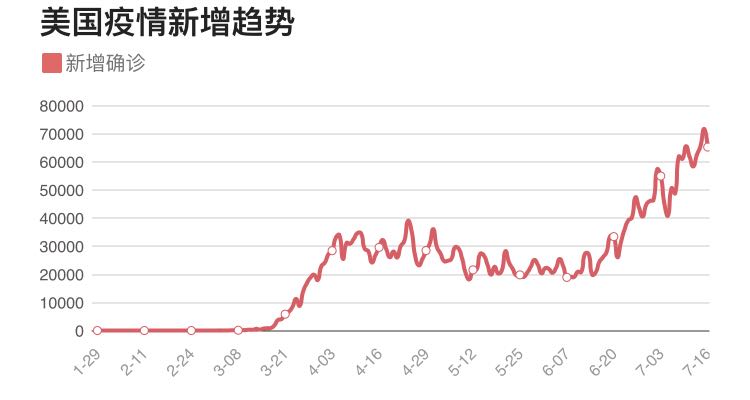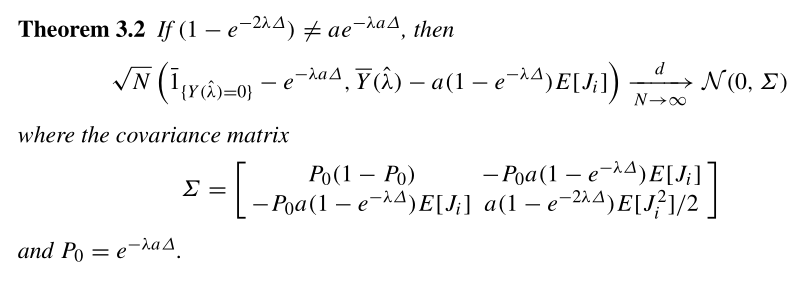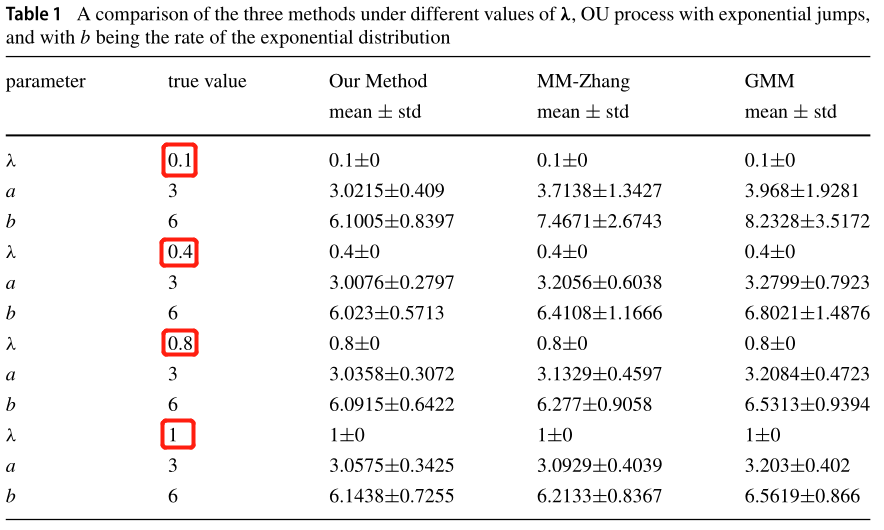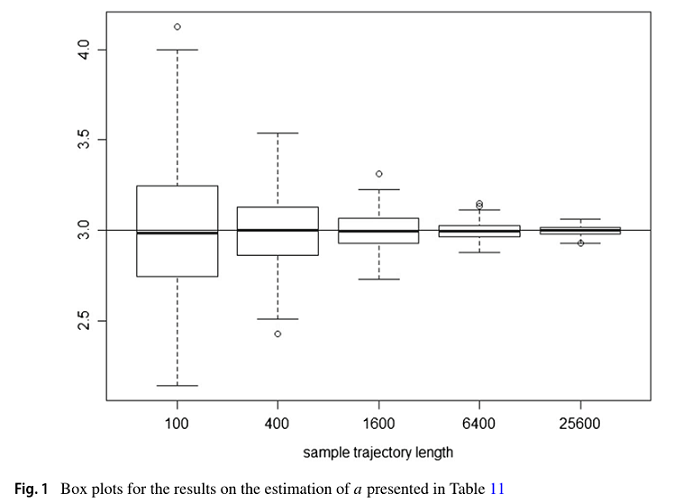class: center, middle, inverse, title-slide # Parameter Estimation of OU Process and its extensions ### Yanfeng Wu ### School of Finance, JXUFE ### 2021-06-08 --- # Ornstein-Uhlenbeck (OU) process Stochastic Differential Equation (SDE): $$ dv(t) = -\lambda v(t)dt + dl(\lambda t) $$ where `\(l(t)\)` is a Lévy process (**B**ackground **D**riving **L**évy **P**rocess: **BDLP**), i.e., satisfying the following properties: 1. `\(l(0) = 0\)` almost surely; 2. Independence of increments; 3. Stationary increments; 4. Continuity in probability. -- Examples of Lévy process: - Brownian motion - Poisson process, Compound Poisson Process - Gamma process, ... --- # A trajectory of an OU process .center[] ??? --- # Applications of OU process - interest rate, Cox-Ingersoll-Ross model (**CIR**-model) - stochastic volatility, Barndorff-Nelsen and Shephard model (**BNS** model) - membrane potential of a neuron - earthquake series - Levy-driven CARMA (Continuous ARMA, **A**uto**R**egressive **M**oving **A**verage) --- # Applications of OU process (continue...) - **COVID19**: modelling the daily increment series?  --- # Parameter Estimation of OU process **SDE (Stochastic Differential Equation)**: $$ dv(t) = -\lambda v(t)dt + dl(\lambda t) $$ <span style='font-size:50px;color: gray;'>⇒</span> $$ v(t) = e^{-\lambda t}\left[ v(0) + \int_{0}^{t}e^{\lambda s}dl(\lambda s) \right] $$ Given: - `\(v(t)\)` is observed at equidistant points `\(t=0,h,2h,3h,\cdots\)`, - `\(l(\lambda t)\)` is unobservable, how to estimate the parameters? --- ### Recursive Equation `$$v_n = e^{-\lambda h}v_{n-1} + \int_{(n-1)h}^{nh}e^{\lambda(s-nh)}dl(\lambda s)$$` where $$ v_n \triangleq v(nh). $$ Let `\(X_n\)` denote a sample trajectory of `\(v_n\)` `\(, n=0,\cdots,N\)`. -- Further, we define a new variable `$$Y_n = X_n - e^{-\lambda h}X_{n-1}, \quad \forall n=1,\cdots N$$` which are **i**ndependent and **i**dentically **d**istributed (**i**.**i**.**d**.). `$$Y_n \overset{d}{=} \int_{(n-1)h}^{nh}e^{\lambda(s-nh)}dl(\lambda s)$$` --- ### Estimation of `\(\lambda\)` `$$\rho(1)=corr(v_{nh},v_{(n-1)h}) = e^{-\lambda h},$$` <span style='font-size:50px;color: gray;'>⇒</span> $$ \hat{\lambda}_{N,h} = -\frac{1}{h}\log(\hat{\rho}_N(1)) $$ where `$$\begin{align*} \hat{\gamma}_N(s) &= \frac{1}{N-s+1}\sum_{i=0}^{N-s}(X_{i+s}-\overline{X})(X_i - \overline{X}),\\ \hat{\rho}_{N}(s) &= \frac{\hat{\gamma}_N(s)}{\hat{\gamma}_N(0)}, \end{align*}$$` `\(\overline{X}\)` is the sample mean. --- # Estimation of the other parameters Which method to choose? Three common method: - Maximum Likelihood Estimation? - Method of Moments? - Bayessian Inference (MCMC: **M**arkov **C**hain **M**onte **C**arlo)? -- Likelihood ratio function: `$$l(\theta|y_{1:N}) = \prod_{n=1}^{N}f_Y(y_n)$$` where `\(f_Y(\cdot)\)` is the p.d.f. (**p**robability **d**ensity **f**unction) of `\(Y_n\)`: 1. `\(f_Y(\cdot)\)` doesn't have closed-form, therefore 2. neither `\(l(\theta|y_{1:N})\)`. --- ## OU process driven by a Compound Poisson Process The **BDLP** `\(l(\lambda t)\)` is a Compound Poisson Process, i.e., `$$\begin{align*} X_n &= e^{-\lambda h}X_{n-1} +\sum_{i=N(\lambda(n-1)h)+1}^{N(\lambda nh)}e^{(s_i-nh)\lambda}J_i,\\ Y_n &= \sum_{i=N(\lambda(n-1)h)+1}^{N(\lambda nh)}e^{(s_i-nh)\lambda}J_i. \end{align*}$$` Note: 1. `\(N(\cdot)\)` is a Poisson process with rate `\(a\)`, `\(s_i\)` is the ith arrival time 2. `\(J_i\sim \mathcal{J}(\cdot,b)\)` --- ### Moment Calculation `$$\begin{align*} E[Y_n]&=E\left[\sum_{i=N(\lambda(n-1)h)+1}^{N(\lambda nh)}e^{(s_i-nh)\lambda}J_i\right]\\ &=a(1-e^{-\lambda h})E[J_i]\\ E[Y_n^2]&= (\lambda ah)E[e^{2(s_i-1)\lambda h}]E[J_i^2]\\ &~~+(\lambda ah)^2E^2[e^{(s_i-1)\lambda h}]E^2[J_i]\\ E[Y_n^3]&=\cdots \end{align*}$$` Another variable $$ 1_{Y_n=0} = `\begin{cases} 1 & \text{if } Y_n = 0,\\ 0 & \text{otherwise}. \end{cases}` $$ $$ E[1_{Y_n=0}] = e^{-\lambda ah} $$ --- ### Estimators Estimator<sup>[1]</sup> of `\(\lambda\)`: `$$\begin{equation}\label{eq:lambdaEst} \hat{\lambda}= \begin{cases} -\frac{1}{\Delta}\log\left(argmax_r \sum_{n=1}^{N}1_{\{r=r_n\}}\right), & \text{ if } \max_r\sum_{n=1}^{N}1_{\{r=r_n\}} \ge 2, \\ -\frac{1}{\Delta}\log(\hat{\rho}_1), & \text{ otherwise, } \end{cases} \end{equation}$$` Method of Moments for the rest parameters: `$$\begin{align*} \hat{a} &= -\frac{1}{\hat{\lambda}\Delta}\ln\bar{1}_{\{Y(\hat{\lambda})=0\}}\\ E[J_i] &= \frac{\overline{Y}(\hat{\lambda})}{\hat{a}(1-e^{-\hat{\lambda}\Delta})} \end{align*}$$` .footnote[ [1] when the jump size is always positive `$$\hat{\lambda}=\frac{1}{\Delta}\max_{1\le t \le N}\{\ln X_{t-1}-\ln X_t\} ~~~~~~ \text{and}~~~r_{n}=\left|\frac{X_{n}}{X_{n-1}}\right|, ~ n = 1,\cdots,N.$$` ] --- ### Performance: Central Limit Theorem   --- ### Numerical Results  --- ### Numerical Results (continue...)  --- # OU Stochastic Volatility Model $$ `\begin{align*} dr(t) &= (\mu + \beta v(t))dt + \sqrt{v(t)}dw(t),\\ dv(t) &= -\lambda v(t)dt + dl(\lambda t), \end{align*}` $$ where - `\(w(t)\)` is a Brownian motion (Weiner process); - `\(w(t), v(t), l(\lambda t)\)` are unobservable. -- $$ `\begin{align*} y_n \triangleq \int_{(n-1)h}^{nh}dr(t) \end{align*}` $$ $$ y_n = \mu h + \beta q_n + \sqrt{q_n}\epsilon_n $$ where `$$q_n = \int_{(n-1)h}^{nh}v(t)dt, \quad \epsilon_n \overset{i.i.d.}{\sim} N(0,1)$$` --- ### Estimation .center[] Details: [Method Of Moments Estimation For Lévy-Driven Ornstein–Uhlenbeck Stochastic Volatility Models](https://doi.org/10.1017/S0269964820000315) --- # References and unsolved problems References: 1. [Wu, Y., Hu, J. and Zhang, X., 2019. Moment estimators for the parameters of Ornstein-Uhlenbeck processes driven by compound Poisson processes. Discrete Event Dynamic Systems, 29(1), pp.57-77.](./2019-JDEDS-WuHuZhang.pdf) 2. [Yang, X., Wu, Y., Zheng, Z. and Hu, J.Q., 2020. Method Of Moments Estimation For Lévy-Driven Ornstein–Uhlenbeck Stochastic Volatility Models. Probability in the Engineering and Informational Sciences, pp.1-30.](./2020-PEIS-YangWuZhengHu.pdf) 3. [Wu, Y., Hu, J. and Yang, X., 2020. Moment estimators for parameters of Lévy-driven Ornstein-Uhlenbeck processes. submitted to JTSA.](./JTSA_Submit_LevyDrivenOU_MM_draft_Proof_hi.pdf) .footnote[ [1] https://link.springer.com/article/10.1007/s10626-019-00276-y [2] https://doi.org/10.1017/S0269964820000315 ] --- ### Unsolved Problem: Superpositions of OU processes `$$\begin{align*} v(t) &= w_1v_1(t) + w_2v_2(t),\\ dv_1(t) &= -\lambda_1v_1(t)dt + dl_1(\lambda_1 t),\\ dv_2(t) &= -\lambda_2v_2(t)dt + dl_2(\lambda_2 t) \end{align*}$$` where `\(w_1\)` and `\(w_2\)` are weights. -- ### Cases: .center[ 1. `\(w_1 = w_1 = 1,\)` 2. `\(w_1 + w_2 = 1,\)` 3. `\(\lambda_1 = \lambda_2\)`, 4. `\(\lambda_1 \ne \lambda_2\)` ] --- ### Unsolved Problem: Superpositions of OU processes SV Model `$$\begin{align*} dr(t) &= (\mu + \beta v(t))dt + \sqrt{v(t)}dw(t),\\ v(t) &= w_1v_1(t) + w_2v_2(t) \end{align*}$$` where `$$\begin{align*} dv_1 = -\lambda_1v_1(t)dt + dl_1(\lambda_1 t),\\ dv_2 = -\lambda_1v_2(t)dt + dl_2(\lambda_2 t). \end{align*}$$` -- ### Cases: .center[ 1. `\(w_1 = w_1 = 1,\)` 2. `\(w_1 + w_2 = 1,\)` 3. `\(\lambda_1 = \lambda_2\)`, 4. `\(\lambda_1 \ne \lambda_2\)` ] --- ## Q & A Questions and Answers